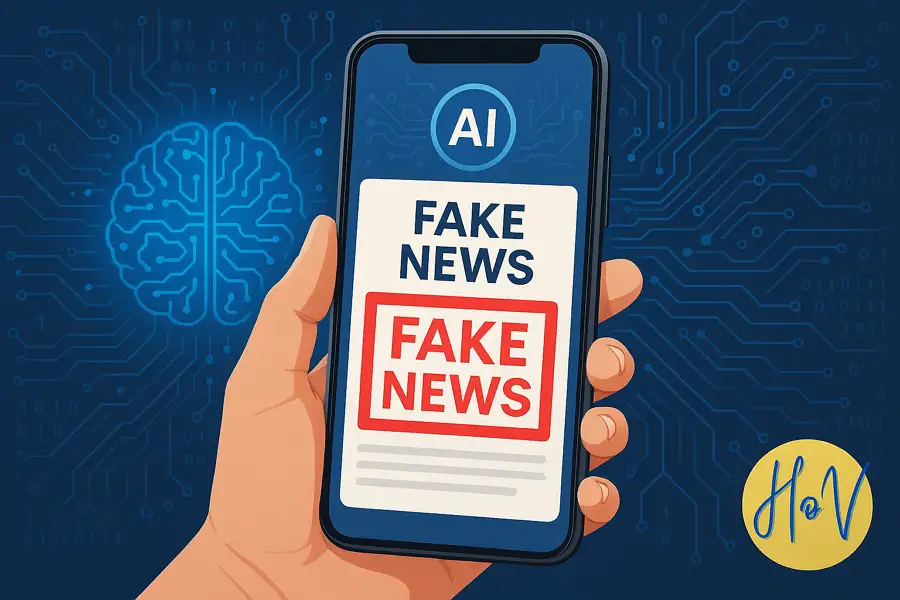We all scroll through our feeds every day, and fake news has gotten tricky to spot. Deepfakes, voice clones, and bogus posts are popping up faster than ever, and they can fool even the most tech-savvy of us. The problem is that misinformation spreads fast, stirring confusion and chaos.
But here’s the good part—AI isn’t just creating fakes; it’s also fighting them. From phone apps that scan videos for manipulation to fact-check bots that analyze claims, you’ve got smart tools right in your pocket. This post breaks down how AI can help you catch fake stuff before it spreads and how to use those tools like a pro 📱🤔
And don’t worry, we’ll keep it simple. If you’ve got a phone and a few minutes, you’ll have what you need to filter the lies from the truth like a digital detective.
Why spotting fake news is getting tougher
AI can imitate people’s looks, voices, and writing styles, which makes anything online feel real. Some sites even publish entire fake reports that look legit, using polished grammar and visuals generated by AI. Tools like Sora and image generators have made it nearly impossible to trust what you see at first glance.
Another issue is how fast it all spreads. A single tweet or TikTok can reach millions before fact-checkers even see it. That’s why using AI tools on your phone isn’t a gadget thing anymore, it’s your first line of defense against being misled.
How AI tools detect fake stuff on mobile
AI detection apps use machine learning to flag sketchy content. They look for odd language patterns, missing context, or digital fingerprints that point to manipulation. For example, FakeOut and Scam Check use AI to spot deepfakes or AI-generated text. These apps scan for things like blurred hands, unnatural shadows, or robotic voice tones that give fakes away.
Researchers at Keele University even made a model that detects fake news with 99 percent accuracy using what they call “ensemble voting,” which means combining multiple AI judgments before deciding if a story is false. Apps inspired by methods like this are already running on Android and iPhone for everyday users.
Step-by-step to recognize fake news with your phone
- Download a trusted AI tool like FakeOut, Scam Check, or Microsoft NewsGuard.
- Copy the link or upload the image or video you want to verify.
- Let the app scan it for visual or language anomalies.
- Review the AI report. It’ll rate trust levels or mark suspicious parts.
- Cross-check that story on search engines or fact-check sites like Snopes or Reuters.
- Look for other sources with the same news and compare dates or quotes.
- Inspect usernames or profiles for missing bio info or recycled photos.
- Read comments other users may have exposed the fake already.
- Report fake posts using your platform’s tools.
- Stay skeptical even when something looks “too real.”
Common mistakes when using AI to fight fake news
Some people rely on one app alone, but no tool is flawless. Algorithms can misread satire or low-quality uploads as fake. Also, deepfakes are evolving, and scammers tweak content to bypass AI filters. So, don’t let the tech do all the thinking, use your judgment too.
Another mistake is ignoring context. Even real footage can be presented misleadingly when taken out of timeline or cropped from its full video. AI tools can help, but checking the original post date and reading other reports is still your call.
Conclusion
Fake news isn’t going away, but with AI on mobile, you can stay a few steps ahead. These tools can’t guarantee perfection, but they make spotting shady content easier and faster.
Keep your apps updated, think before sharing, and question what shows up on your screen. The truth is just a few taps away if you ask the right questions 🧠📲
FAQs
How do AI apps detect fake news?
They analyze text, photos, and videos for signals like inconsistent lighting, weird phrasing, or AI fingerprints.
Are these tools free to use?
Many like FakeOut or NewsGuard have free versions, with extra features available in paid plans.
Can AI detect deepfake voices too?
Yes, some tools catch audio mismatches or synthetic tones in recordings.
What if an app says a story is false by mistake?
It happens. Double-check with manual searches or established news outlets before making a judgment.
Why do people keep making fake news?
Because it grabs attention, sparks emotion, and sometimes spreads politics or scams it’s engagement bait.

Leave a Reply